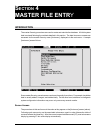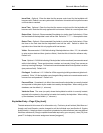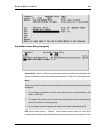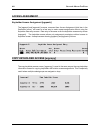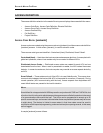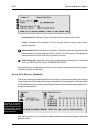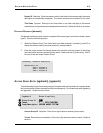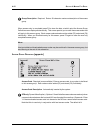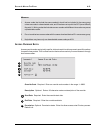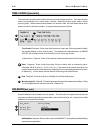
SECTION 4: MASTER FILE ENTRY 4-9
ACCESS DEFINITION
The access definition selection in the master file entry menu displays the access definition menu:
• Access Code Entry, Access Code Definition, Elevator Definition
• Access Group Entry, Access Group Definition
• Access Override Entry
• Fail Soft Entry
• Project Definition
ACCESS CODE ENTRY [acdsentr]
Access codes are created using the access code entry [acdsentr] and the access code definition
[acodentr] screens. A third screen, [eleventr], is used for elevator codes.
Three access code types are identified—Centralized (Host); Distributed; Smart Failsoft:
Centralized (Host) — Used when the host computer makes access decisions. An example is with
global anti-passback, where in/out readers may be connected to different ACUs.
Distributed Access Codes — Distributed access codes are created for each ACU and are
downloaded from the host. When a card is presented to a reader, the ACU makes the access
decision. In some circumstances, the host computer may override an access request denied by
an ACU.
Smart Failsoft — These codes work only if the ACU is in smart failsoft mode. This occurs when
communication between the host and the ACU is interrupted for more than 15 seconds. During
normal operation (ACU communicating with the host), access requests from keyholders with
smart failsoft status are passed to the host for decision.
NOTE
Smart failsoft is not supported with 1050 keys used in conjunction with 708P and 718P ACUs, but
a function is built in to the units which does provide some measure of failsoft protection in the event
of a communications failure with the host. The ACUs can be programmed to accept up to 25
specific command keys, and access is allowed when these are presented (access may be for one
to eight doors). The feature is limited to some extent in that time codes cannot be used in
conjunction with this special programming, and event entries (door opening records, in this case)
are not logged.
A sample [acdsentr] screen follows:



